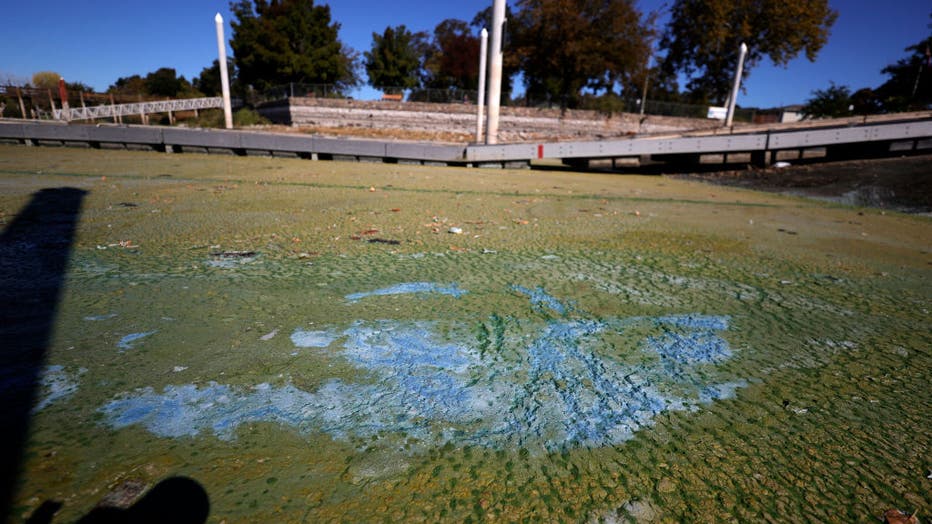Harmful algae detected at Red Bud Isle, treatment to begin in coming days
AUSTIN, Texas - The presence of harmful algae has been detected at Red Bud Isle by the City of Austin Watershed Protection Department.
The algae, a species of Cyanobacteria, also known as blue-green algae, showed up in lab results in a sample taken from Red Bud on May 30, 2022. The algae is a potent neurotoxin and can make people and pets sick. It has been detected in samples from Lady Bird Lake in previous years.
In 2019, several dogs died after swimming in Lady Bird due to the harmful algae bloom. A harmful algae bloom or proliferation is when algae produce various toxins under favored conditions such as high temperatures.

CLEARLAKE, CALIFORNIA - SEPTEMBER 26: Blooms of cyanobacteria, also called blue-green algae, cover the surface of the water in Clear Lake at Redbud Park on September 26, 2021 in Clearlake, California. Residents and visitors of Clear Lake, California'
Phoslock treatment may be a way for Watershed Protection to reduce the presence of harmful algae.
Phoslock is a clay material that binds to phosphorus, which is a key source of nutrients for algae. Once bound into a mineral form, the phosphorus becomes unavailable to the algae. By lowering the nutrients levels in the lake, Phoslock essentially robs the algae of a primary food source, ultimately slowing its spread.
Watershed Protection applied Phoslock over 20 acres of Lady Bird Lake near Red Bud Isle. The department says a 40% reduction in the amount of phosphorus available to algae was the result. The reduction has persisted over nine months, according to sediment testing in May 2022.
The department says it will expand Phoslock treatment to include the north shore of Lady Bird Lake from I-35 to the lagoon by the Festival Beach boat ramp. The location was chosen due to the results of algae samples collected from the area.
About 30,000 pounds of Phoslock will be applied to the area Monday and Tuesday of next week, June 13 and 14. Phoslock will also be reapplied to Red Bud Isle on June 15. Additional treatments will occur over the summer. The city will be spending $300K on these treatments, testing and lab work.
Watershed Protection says boaters should avoid the area during treatment and keep plenty of distance from the barge applying the Phoslock. The barge sprays a gray slurry into the lake, temporarily clouding the water. It is safe for humans, the environment and wildlife, and takes a few hours to settle to the bottom of the lake.
The department wants residents to be aware that although the treatment reduces the amount of harmful algae, it may still be present. Other dangers such as bacteria and parasites may also be present.
Watershed Protection offers the following recommendations to those enjoying the outdoors this summer:
- Look for water that is cool and flowing
- Avoid contact with algae
- Rinse after swimming in natural water bodies
- Do not allow dogs to lick their fur prior to rinsing off
- Do not enter warm, stagnant water or water containing scum, film, or algae
- Stay out of water if it has rained in the past three days, or if there are dogs present
Lady Bird Lake and Lake Austin will be monitored biweekly by Watershed Protection for harmful algae through the summer. Sampling results can be viewed online at AustinTexas.gov/Algae. The department says there is a one-to-two week turn around time for results.
Lake conditions may vary, as environmental conditions can change rapidly. Visitors are encouraged to acess the conditions at the time of their visit, avoid shorelines and backwater areas and treat algae like it may be toxic.

